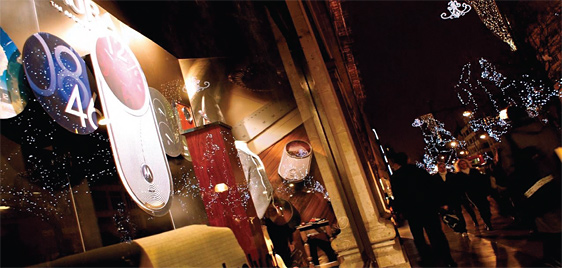
 |
Motorola is a device manufacturer that is known for its design-savvy. From the Razr to the Rokr, to the ultimate luxury handset, the Aura, this business knows how to turn heads. Andrew Morley, vice president of marketing for mobile devices in Europe, Middle East, Africa, Russia and Asia, is responsible for directing Motorola’s mobile device marketing, brand and online communications strategy across the region, while ensuring prominence for Motorola’s current and upcoming mobile device portfolio. Here, he explains where the brand stands in the luxury end of the marketplace…
Motorola’s brand has always fit the luxury market. It recently celebrated its eightieth anniversary as a company and the twenty fifth anniversary of the first mobile phone, which it invented. It made the first clam-shell, then the thinnest one, and it was the first handset manufacturer to partner with a luxury fashion brand - Dolce and Gabbana - and the first to offer a luxury oriented product.
This manufacturer is a brand that has always been known for its design. Without sacrificing innovation, it insists on quality production materials, which
is one reason Motorola is a trusted brand able to enter the luxury market on its own merits, states Morley.
Feel the Aura
The latest luxury product from Motorola, the Aura, is the perfect example of the company’s design heritage. It has an innovative, world’s first circular display, a Swiss made main bearing and is made of materials including stainless steel and 62 carat sapphire crystal. The screen shows 16 million colours and has a resolution of 300 dpi, which is the same as that of a magazine.
Commenting on the Aura, Morley says: “When you hold the phone you can feel the weight of the materials we use. There are 200 parts that make it up. When you open and close it, the same fluidity in the device will be felt each time. The front cover of the device takes two weeks to make by hand. It’s a premium product for consumers who are looking for something unique.
“With Aura, Motorola enters the luxury market but also proposes a return to traditional values, to things that last,” continues Morley. “This product is the result of true craftsmanship, like in old times when clothes were made by a tailor and would last 20 years. In the current economic climate, these artistic values are even more important. Aura’s tagline is ‘The return of artistry’.”
Back to basics
The recession is hitting every part of the industry, but in these times, states Morley, we all go back to the basics, to traditional values that embody quality and timelessness. “We think Aura is the perfect handset to offer this return to tradition. In difficult times people tend to buy less but are certainly more deliberate about what they buy, and are looking for durability, quality and craftsmanship. Aura is a phone for people who value these qualities and want something to express their personality. It’s an exclusive product, so it’s always going to be one for individuals looking to stand out from the crowd.”
Morley adds: “In these difficult times I hope people will return to traditional values, sort of a back to basics period. This would include respecting craftsmanship. We’d all go for things built to last, those that were high quality and beautiful.”
Staying in the luxury market fits Motorola’s brand DNA, Morley explains. The company is taking its time to enter the market correctly and although it does not talk about future products per say, he insists dealers can be sure they will always have a good looking phone to sell from Motorola.
He comments: “Our designers truly enjoy creating works of art, and as marketers we certainly like bringing them to consumers. It’s a different way to engage in the selling process and one that is interesting and challenging to us.”
Morley is no stranger to luxury; he joined Motorola in 2007 from Harrods, where he served as the group marketing director, managing marketing and strategic communications for the renowned retailer and its associated business. He also has a long career behind him in telecoms and IT. Prior to joining Harrods, Morley was chief commercial officer at Cable and Wireless, and before that was director of marketing and sales at BSkyB.

Brand strategy
He says: “As I learned at Harrods, the luxury market and its consumers are unique, so we have had to adapt our retail strategy. In Spain for example, Motorola partnered with El Corte Ingles. Usually, we don’t sell mobile handsets through luxury department store channels, but because it was so exclusive, they were one of our key distributors in that market. In the UK we partnered with Selfridges and had a beautiful front window display on Oxford Street during the key Christmas period.
“In Milan we created an exclusive store front featuring Aura and a luxury tailor. This was in the prestigious Corso Como district where people could look, touch, try and buy an Aura, while living the handcraftsmanship experience by buying personally designed shirts. It’s about creating an experience that links to the product, is appropriate and sparks interest and desire to purchase. Each market we enter presents a new opportunity to sculpt our retail strategy with this goal in mind,” he explains.
Morley states it is about creating a balance of traditional outlets, luxury department stores and more boutique, bijou retail environments for Aura. “You have to adapt your point of sale materials and ad campaigns to ensure you’re creating the right environment, attracting the right individuals,” he enthuses. “We may not have the retail network of Gucci or Louis Vuitton, but we have the ability to mix different channels so our offer is at the right place in the right moment for our consumers. Luxury isn’t democratic. We take a clear simple point of view and then execute against it.”
Android buzz
As for what is coming, Morley says that what is really creating a lot of buzz in the industry, and is keeping the entire market impatient, is Android. This platform is set to shake up the industry, he states. “This new platform is really changing the game and may turn the industry upside down. Nowadays,
consumers are no longer looking only for the best hardware, but for the right software. Consumers have their life in their phones, and they want an easy interface.
“Android is a new force, changing the way manufacturers build their phones and also operators’ offerings. But most importantly, it will change the relationship consumers have with their phones,” he continues.Android opens up a huge range of possibilities for the growing sophistication of both the manufacturer and the consumer, Morley claims.
He adds: “The mobile and the laptop will continue to converge. Consumers will be able to develop their own applications and personalise their phones. What is also really interesting, compared to the iPhone, is that Android is open source, and not tied to a manufacturer. It means development, creativity and adaptation will remain key, offering freedom to operators and manufacturers to provide different services, form factors and applications to the end consumers.”
This new open creativity, plus today’s economy, will also increase cooperation within the industry concludes Morley. “I think we’ll enter a new level of partnership in the UK mobile industry. Thanks to the adversity in the market, different parties, from retailers to operators and manufacturers, will come together to create even more innovative products and services.”
